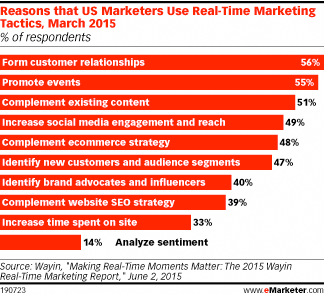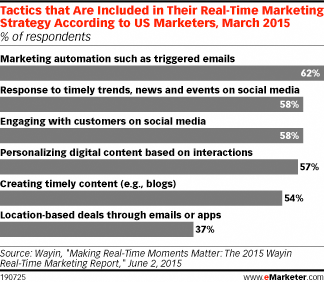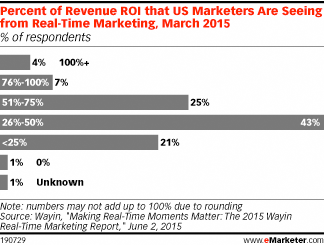As Real-Time Marketing ROI Increases, Spending Follows
June 20, 2015
![]() Marketers have embraced real-time marketing (RTM) to reach a multitude of goals, and their efforts aren’t just limited to social media. Recent research finds that real-time marketers are funneling more money toward such tactics, and they’re reaping the benefits.
Marketers have embraced real-time marketing (RTM) to reach a multitude of goals, and their efforts aren’t just limited to social media. Recent research finds that real-time marketers are funneling more money toward such tactics, and they’re reaping the benefits.
 March 2015 research by Wayin, which looked at 200 US marketers who currently practiced RTM, found that marketers used it for a wide variety of reasons. When asked why they practiced RTM, 56% cited forming customer relationships, and a close 55% did so for event promotion. Adding to existing content, increasing social media engagement and reach, complementing ecommerce strategy and identifying new customers and audience segments were each cited by about half of respondents.
March 2015 research by Wayin, which looked at 200 US marketers who currently practiced RTM, found that marketers used it for a wide variety of reasons. When asked why they practiced RTM, 56% cited forming customer relationships, and a close 55% did so for event promotion. Adding to existing content, increasing social media engagement and reach, complementing ecommerce strategy and identifying new customers and audience segments were each cited by about half of respondents.
Social media is an ideal place to interact with consumers in real time, and the study found that responding to timely trends, news and events on social as well as engaging with customers on such platforms were each included in 58% of respondents’ RTM strategies.
 RTM went beyond social though, as 62% cited marketing automation, such as triggered emails in response to consumer actions, as part of their RTM efforts. Personalized content based on interactions and timely content creation, such as blogs, were each used by the majority of respondents as well.
RTM went beyond social though, as 62% cited marketing automation, such as triggered emails in response to consumer actions, as part of their RTM efforts. Personalized content based on interactions and timely content creation, such as blogs, were each used by the majority of respondents as well.
 Fully 58% of respondents attributed more than 40% of their marketing budgets to RTM, and nearly six in 10 intended to increase spending in the next year. This makes sense when one considers the return on investment (ROI) that respondents had already seen. Fully 36% reported seeing more than half of revenue ROI from RTM, and an additional 43% saw between 26% and 50%.
Fully 58% of respondents attributed more than 40% of their marketing budgets to RTM, and nearly six in 10 intended to increase spending in the next year. This makes sense when one considers the return on investment (ROI) that respondents had already seen. Fully 36% reported seeing more than half of revenue ROI from RTM, and an additional 43% saw between 26% and 50%.
Percent of Revenue ROI that US Marketers Are Seeing from Real-Time Marketing, March 2015 (% of respondents)
However, other research suggests that marketers as a whole still struggle to leverage RTM. When a December 2014 study by Econsultancy asked client-side marketers worldwide about the extent to which they optimized the customer experience for select goals/tactics, just 17% said they responded in real time to voices of customers thoroughly. Just under half (49%) did so partially, while 34% didn’t do this at all.
Courtesy of eMarketer




























